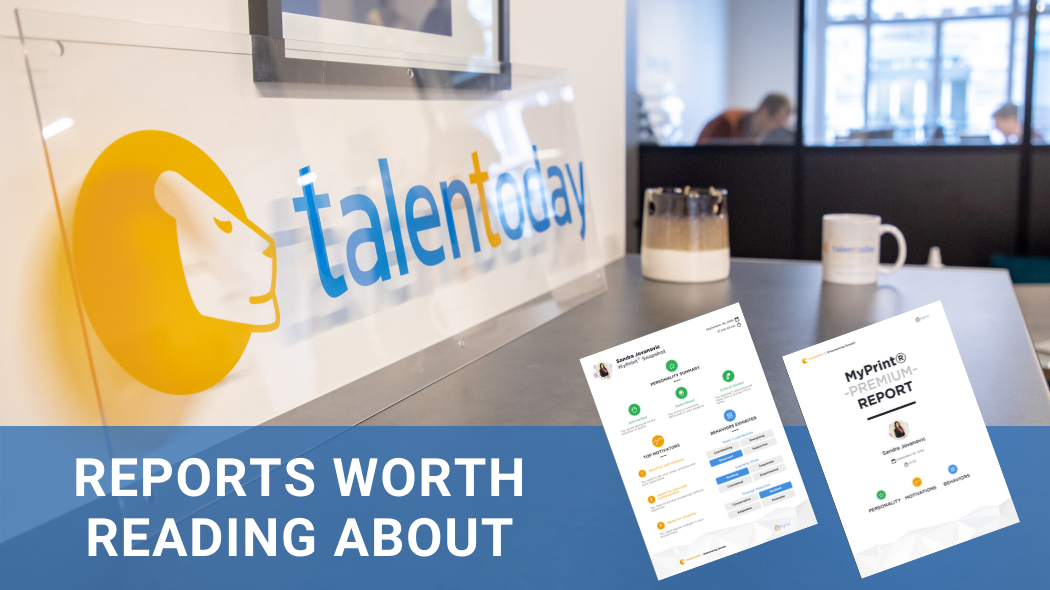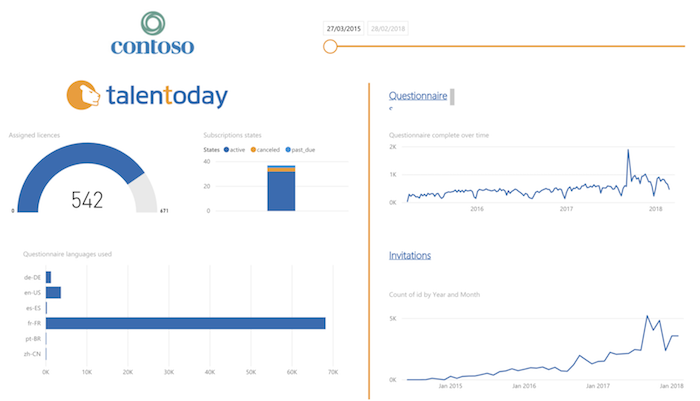Are Remote Workforces Shaping a “New Normal”?
At times like this, it can be difficult to see the light at the end of the tunnel, as our personal and professional lives are sent in disarray as we cancel, adjust and adapt. It is important to remember during this difficult and complicated time that we WILL get past all of this, and things will go back to normal. But what exactly does normal mean? Of the adaptations we make in business and at home over the course of time to come, what residual long-term impacts will this have on how we communicate, perceive, socialize and work?
To gain insights on the latter, we spoke with an expert in the world of work, Andrew Limouris, the global CEO of Talentoday and CEO of Medix, a staffing company based out of Chicago, for his opinions on how the paradigm of work might shift.
What immediate impacts have you seen from your purview in staffing on how organizational operations have adjusted at this time?
“Obviously with the early warnings of an imminent social isolation order, the very first shift we noticed was internal meeting cadence and structure. People became more conservative and concise in conversations, and organizations scrutinized which meetings were truly necessary face-to-face versus over email. Then came the shift to entirely remote workforces. Organizations needed to entrust their teammates to carry out their duties in remote settings, therefore adjusting communication and in some cases accountability measures. Individuals needed to self-discipline and set up their day to achieve success in sometimes distracting environments. Technological accommodations had to be made on organizational levels. And organizations clamored to figure out how to keep team culture alive and remove collaborative barriers that could be achieved through technology now that physical barriers were imposed. The key for everything has been understanding: understanding who your people are- both their hard AND soft skills, understanding who your managers are, understanding the environments that make them successful, and understanding their viewpoints and perspectives.”
What external impacts has that had on organizations, especially those like yours in the services industry?
“For Medix, we serve two different groups of ‘clients’: the talent we place and the companies we place them at. For interviewing talent, it is our literal job to ensure we understand who they are, their aspirations, their motivations, their strengths and weaknesses, to place them in environments and opportunities they will thrive in. Shifting to complete online interviewing adds just one more layer to chip through in getting to truly know someone. On a company/client group level, with all meetings being switched to virtual, organizations find it that much more imperative to understand goals and intentions as early as possible in a conversation in order to maximize the impact of virtual meetings that tend to have enough distraction and mental interruption as is. It isn’t insurmountable, but it has been a challenge.”
What have been the positive ramifications of these changes?
“I believe organizations are finding new efficiencies that might not have existed before. Our communication has become more concise, and by virtue, oftentimes more powerful. One beautiful thing that has emerged in organizations is trust. Companies are setting up the accountability infrastructure for truly efficient and empowered teams. Employees tend to appreciate this autonomy, which can reap benefits in increased engagement and psychological safety with their places of work.”
What are some of the challenges?
“Operationally speaking, it is already intensely difficult to source, screen, hire, onboard, motivate, engage and grow effective teams. If it was easy, companies like Medix or Talentoday wouldn’t exist. The only way to do this effectively, as I mentioned, is to have a deep, robust understanding of who a person intrinsically is- not just what’s on their resume. Not just what they tell you in annual reviews. Adding a veil of technology only intensifies those challenges. My biggest fear regarding remote work is and always has been the impact it could have on our culture. Maintaining team collaboration and a cohesive vision in a remote environment is tough.”
What are your thoughts on the long-term impacts and how to handle them?
“It’s most organizations’ goal to achieve operational and financial efficiencies, so as companies spend the months ahead figuring out how to maximize their teams’ time and energy, I would not be surprised to see less lengthy meetings in boardrooms in the future, and many more flexible work programs surface. If they prove to be effective operationally, as well as motivating or incentivizing to employees, I would expect employers who might have been adverse to them in the past experimenting with implementing more widespread remote offerings to teammates. The caveat is going to be to continue to balance those efficiencies and benefits with the costs and risks I mentioned. What can be achieved through technical skills can sometimes be interrupted with soft-skills incongruencies due to environment and work styles, and aligning individuals with roles, teams and cultures that don’t need physical presence to be effective will be increasingly important.”
With still uncertain times on the horizon, one thing that is certain is that for employers and citizens at large, we will want to spend this time deepening our understanding of our companies, our teams, our social circles and ourselves, in order to best adapt to the potentially long-term or in some cases even permanent aftermath to our workstyles and lifestyles in general.
If you’re interested in learning more information about Talentoday, please visit www.talentoday.com or contact our experts at contact@talentoday.com.
Unique Results You Can Actually Use
It is human nature to be curious. That is why we hear children ask “why?” over and over again or take the online social media quizzes knowing that there is no validity in their results, but we are simply curious as to what TV character they might say we are or what movie our personality is most like.
When it comes to our personalities and soft skills, the right tools will allow you to leverage technology in order to capture, represent and report our human elements that make us unique in a simple way. That is exactly what Talentoday’s One Page and Premium Reports do!
Whether you are interested in learning more about yourself or thinking about using these reports to manage your team, let’s spend a couple minutes together learning about these two reports.
A Quick Review
After completing the MyPrintⓇ questionnaire, your results will be visualized into reports as a one-page or premium report. There are a total of 26 possible personality traits, 22 motivations and 44 possible behavioral types that will make up your unique results. Just think about the possibilities!
Three high-level definitions to keep in mind before we dive into the reports:
- Personality traits are used to describe the attitude and emotional characteristics of an individual
- Motivators are the reasons an individual acts or behaves in a particular way
- Behaviors help us understand how an individual acts or conducts themselves towards others
One Page Report
If your time is valuable and you want to understand the most pertinent information in a summarized format, then the one page report will be your best friend. This report is separated into three segments, including a personality summary, top motivators and behaviors exhibited. Essentially, it highlights the need-to-know information about your soft skills in each of the three areas and identifies the traits that make you, you!
The personality summary section displays the top three most distinct personality traits an individual possesses based on what Talentoday measures in our questionnaire. The top motivators section displays the top three most distinct motivators for an individual. Lastly, the behaviors exhibited section displays the three predominant behavioral styles of an individual.
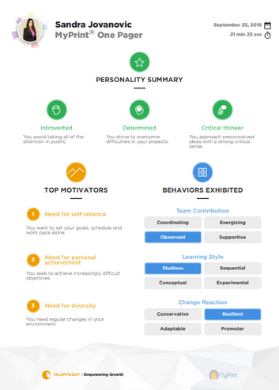
Premium Report
Now don’t worry, because we know comprehensive detail can’t be summarized in one page. So for all you that love to dig into the details, our premium report is perfect for you. This report contains over 30 pages of detailed information about every single personality and motivation trait, as well as your behavioral styles. In addition to the granular details, we see well summarized personality and motivation trait visuals with our easy-to-read personality radar and motivations scale.
The premium report not only provides you with the results and descriptions of your results, but also gives you recommendations on how to use those results. As we dig in to each personality trait, you will find additional tips to review. For motivators, we will not only understand what motivates the individual, but also what can discourage that person. In each behavioral style, we can understand the description of the style, assets, and questions to ask ourselves or the individual whose report we may be reviewing to dig into the behavior further.
Interested in what your personality, motivations and behaviors are but haven’t had a chance to experience MyPrintⓇ Of course, we would be too! Contact one of our Talentoday experts at contact@talentoday.com to experience the questionnaire and view your one page report as soon as you answer the last question. We can’t wait to hear what you think.
Stay tuned for more exciting product news! We know that 2020 is going to be ROARing!
If you’re interested in learning more information about Talentoday, please visit www.talentoday.com or contact our experts at contact@talentoday.com.
Employee Recognition to Turn the Holidays into the Season of Company Culture and Commitment
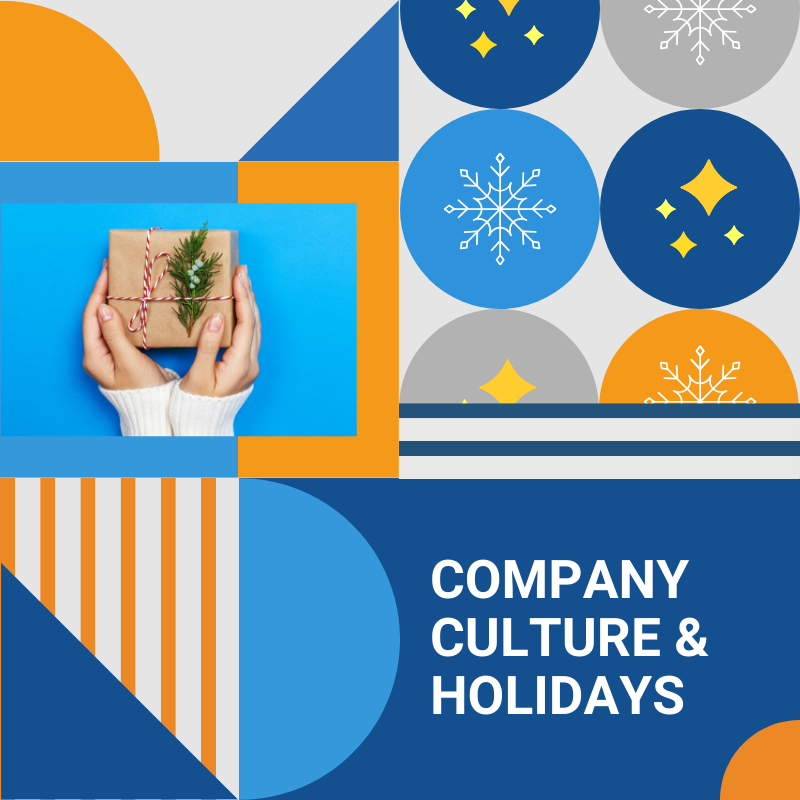
The holiday season can stir up a whirlwind of emotions inside and outside of work — from happy to excited, and for some, stressful. During the holidays, companies and teams may celebrate with special parties and events, but offices can also become ghost towns, with many employees taking additional time off. Adversely for some industries, the holiday season may be their busiest time of year.
Through the high points and low points of the holiday season, what can managers do to keep their employees motivated, while enhancing their commitment to the organization in the new year?
Make it Personal
Some organizations may have the luxury of being able to provide company-wide holiday presents and/or year-end bonuses, which can help with the overall sense fulfillment for employees. However, many companies do not have this option, or they feel like company-wide gifts may seem impersonal.
According to Great Place to Work, “It is key that employers focus on how they can make authentic and meaningful recognition part of their management philosophy in order to retain top talent and encourage high performance.” For managers, knowing that a need for unique recognition is important, the holiday season creates an opportunity to motivate employees on an individual basis to end the year strong!
Recognition Without Breaking the Bank
As can be seen by Talentoday’s assessment, individuals’ motivations are unique. While some people are heavily motivated by money, others may be more motivated by external recognition, or the ability to socialize.
To recognize individuals on your team, it could be as simple as writing an email or handwritten note, highlighting accomplishments throughout the year. Additionally, during the holiday season, employees may have the burden of hectic travel or spending their holidays away from their loved ones. For those teammates, consider giving them snacks for the road, a good book, or recommending a podcast to pass the time. For employees that will be spending time away from family and friends and missing their hometown, consider specific items that would remind them of home, such as candies, drinks, sports memorabilia or photos. Lastly, for employees who spend much of their year traveling for work, this is a great opportunity to provide a gift than can be shared with their family, such as a gift basket or a gift card for a meal together.
Establish Employee Commitment
Unfortunately for some organizations, the phrase, “new year, new me,” can often signal individuals looking to start a new job in the new year. Similarly, the start of the new year often means that new company budgets are established or replenished, allowing organizations to actively recruit.
Knowing this, the holiday season is a great time to ensure and re-establish commitment to the organization. Outside of recognizing individual achievements and rewarding employees on a more personal level, organizations can use this time to come together and reflect on the past year and provide transparency on goals for the upcoming year. Furthermore, outside of company-wide meetings, managers should be frequently engage employees by, “creating a respectful and trusting relationship with their direct reports, communicating company values and setting expectations for the day-to-day business of the organization,” as they play a key role in overall employee engagement.
As organizations are wrapping up their year-end initiatives and gearing up for 2020, it’s never too late to think of unique ways to serve and recognize the people giving back to the company on a daily basis. Whether a company is small or large, personalized actions or recognition can go a long way and can be done with little to no budget, allowing all employers a fair chance to motivate their teams this holiday season!
Leveraging Motivation and Engagement and Navigate Change

In response to an ever-evolving economic environment, companies undergoing institutional change look to leverage the power of employee engagement. However, true employee engagement cannot be imposed, and HR professionals must establish an internal policy of valuing employees before asking them to serve the company’s interests. According to a 2018 CXP survey (1), HR professionals are facing many additional challenges in their role, such as HR quality of service, data reliability, regulatory compliance and administrative productivity. In fact, HR professionals need to have a reliable HR service before tackling the commitment to business transformation through engagement. This is paradoxical in a rapidly changing world, where it is necessary to be agile and where employee engagement is the key to success. This may come as a surprise, the notion of engagement appeared a while back in the 1980s, when companies understood that employee engagement provided a definite competitive advantage (2); yet a lot of work is still to be done to achieve that ultimate goal.
Engagement from a Motivation Perspective
It is not easy to engage employees to serve the interests of their respective organizations. They must first motivate them. Since motivation is intrinsic to each individual and is correlated to their own values and personality, to grow a business, managers need to consider each team’s culture as a unique set of personalities and motivations. It is only by doing so that they can foster engagement and allow the organizational change to happen (3).
Engaging People During Times of Change
Engaging individuals requires a clear definition of the change expected for the working teams, a simple explanation of intent and a convincing argument for change. Managers must also give some elements on the behavior expected of teams and a reasonable timetable. Engagement depends heavily on the relationships between managers and their teams, during times of change it’s important for managers to focus on these relationships to achieve desired results. In doing so, it’s necessary to revisit management methods. For success it’s found that managers must be able to listen, be empathetic, honest and transparent towards their teams (4).
Becoming Human Centric
Companies are increasingly focusing on the individual’s place in the collective and are developing “symmetry of care,” i.e. they are making the quality of the relationship with their employees equal to the one they maintain with their customers. This concept, which appeared in 2007 in the book “Du management au marketing des services” by Benoît Meyronin and Charles Ditandy, is one of the levers of any transformation process. Vineet Nayar’s global success book “People First, Customers Second” goes further by putting employees before customers and is a global success. He advocates management through trust, because according to him, operational employees carry the value of a company. In the front line with customers, they are the ones who bring the real added value because they are willing to create tailor-made services or products capable of meeting the needs or challenges of the market.
In short, the agile transformation of a company takes its momentum from the revolution in managerial methods and leads to cultural changes that value the entire social body.
Sources:
- Employee Engagement and Change Management 1,Dr. C. Swarnalatha , 2,T.S. Prasanna,1,Professor & Head, Department of Management Studies, ANNA UNIVERSITY, 2013.
- Eight best practices of change : engagement, John Quereto, Expresswork,, August 8th, 2017.
- Employee Engagement and Organizational Change, Stavros Georgiades, Frederick University, January 2015.
Leverage Soft Skills to Accelerate Employee Training

According to the Organization for Economic Co-operation and Development (OECD) figures, just under one-third of French people from 25 to 64 attend work-related training each year. Compared against research showing that 32% of jobs will change with technological progress and 14% risk being automated, this shift may cause concern for employers as they look to remain competitive and sustain business in the future. For employers, training will become crucial to address organizational skill gaps with the introduction of new technologies. From the employee perspective, the 2017 Cegos Barometer shows that, while 99% of French employees believe it is important to train throughout life, only 28% of them consider vocational training to be relevant for companies (Institut YouGov study).
Develop Strategic Social Skills
With the reality of declining employee engagement and increasing turnover, a direct consequences of dissatisfaction with professional training, companies must take the lead in developing the social and situational skills that will ensure their success in a changing environment.
Although the workplace is changing to be increasingly digital, this doesn’t limit employers to “hard skills” but also opens the door for “soft skills” training, which provides long term personal and professional development for employees. In a recent survey conducted by RegionJobs, 82% of the 6,790 respondents (324 recruiters and 6466 candidates) voted that life skills are the most important recruitment criteria. This finding was supported by a study completed by the Employment Guidance Council, confirming the importance of socio-emotional skills — such as self-control, problem solving and perseverance — for the emerging and evolving professions.
Unleashing the Company’s Potential by Unlocking the Potential of Employees
In the same survey from RegionJobs, the findings go on to that “life skills while considered crucial, recruiters still tend to be more flexible with them”. This is similar to the rationalization that occurs when people on a diet “cheat”, a common example of cognitive dissonance.
On the other hand, it is imperative for companies to rethink both recruitment and training. Employees need to be assured that the training provided will enable them to develop professionally by addressing both hard and soft skills. While employer-sponsored training will empower employees to become active participants in their development, while benefiting from the current political and legislative incentives, such as training tax benefits.
Rely on New Training Methods
With improvements to digital learning tools, learner engagement has increased through a personalized approach that takes the individual’s personality and motivations into account. Through having engaged learners, organizations are able to manage training programs upstream and develop skills from within their current organization, allowing them to remain competitive while retaining their existing workforce.
Although the positive impact of these tools is apparent at the macro level, it’s no secret that digital learning solutions can be costly to implement. So, can we evaluate the monetary return on our investment? In looking at IBM’s study on the ROI of training they estimated they were able to save nearly $200 million after implementing an e-learning strategy. Furthermore, through a study conducted by the American Society for Training and Development, it was found that an adapted training program improves employee income by 218%.
Changing working environments and attitudes
As new work environments emerge in the digital age, organizations must encourage new behaviours to facilitate learning — such as, manager engagement for communication of objectives, valuing efforts and rewarding success. It’s also critical to review the company’s decision-making processes and ensure it allows for autonomy, while providing flexibility for new initiatives or innovation.
In looking at soft skills, we’re promoting that it is necessary for employers to promote learning for individuals, which implies a de facto — or inherent — change in management style, allowing for more freedom for both managers and employees.
Sources:
- La formation professionnelle en France, est-elle prête pour l’avenir?, OECD, Fev 2019
- La formation professionnelle en 2017, Observatoire Cegos, Oct 2017
- Turnover Report, SHRM 2019
- Salon du Travail et de la Mobilité Professionnelle, CP, 17 Jan 2019
- Enquête : comment recrute-t-on en 2017?, Priscilla Gout, Sep 2017
- Cognitive dissonance, Talentoday Certification, Talentoday, 2018
- Automatisation, numérisation et emploi, Conseil d’orientation pour l’emploie, tome 2: l’impact sur les compétences, Sep 2017
- LOI n° 2018–771 du 5 septembre 2018 pour la liberté de choisir son avenir professionnel, Legifrance
- The Value of Training, IBM Corporation, 2014
Be Unique: One Size Does Not Fit All

The idea of the “employer brand” is becoming exhausted with a flurry of best practices and standards, but we believe the exhaustion relates to companies being out of touch with what employees are really experiencing. Today there is a need for a holistic and authentic approach across the company’s brand, as the company’s employer brand is central to attracting talent and retaining employees. So, how do we bring new life to the “employer brand” at a time when social interaction is being digitized? What if restoring human relationships was the solution?
By returning to its core values, and purpose, companies can start a new foundation and ensure that it’s attracting talent that match its unique company culture. This fact has been a compressed reality for so long that, in France, the Pacte Law has been enacted to help with the transformative challenges and mutations that companies are facing by emphasizing on the corporate social responsibility (CSR) through the introduction of a new moral pact between a company and its social and environmental ecosystem. QED
Distinctiveness is the lasting differentiation
It is therefore vital for companies to reconnect with their ecosystem by working on identifying what makes them unique and what makes their team(s) exceptional. Through reconnecting with their ecosystem, companies will be able to identify their distinctive image and identity. Which will help them to transparently communicate their authentic purpose and true holistic employee experience — attracting and retaining the right people who share their values and integrate into their sub-culture.
Human Centricity
Given the importance of company culture, and how today it is becoming central in human resource strategy, we’re seeing a number of recruiters utilize soft skills (skills related to interpersonal behaviors) when screening and shortlisting candidates. In fact, by shifting their focus to soft skills, companies get the opportunity to revisit their own values and create that distinctive, strong, social and moral pact that candidates can identify with and employees feel empowered by.
Developing a “People Skills” Directory
Each company is unique, each profession is unique, and the chemistry of the employees is unique.One the many ways to achieve coherence and that goal of distinctiveness is the creation of people skills Directory. An index that list employee behaviors which is intrinsically what makes a company’s culture unique. Conclusions can be used to create that authentic employer brand while evolving overtime based on employee feedback.
To attract the right candidates, foster engagement and retain employees, HR professionals can use elements of their company culture to answer the questions “which projects will naturally speak to employees?” and “on which projects will individuals naturally perform well?” to bridge the gap between employee values and the company’s goals. Ultimately, this will allow companies to create a healthy and remarkable work environment, a strong social pact, a strong culture, and a structural — sustainable — economic growth.
Radio, Waves, Neuroscience… Do you Know What They Have in Common?
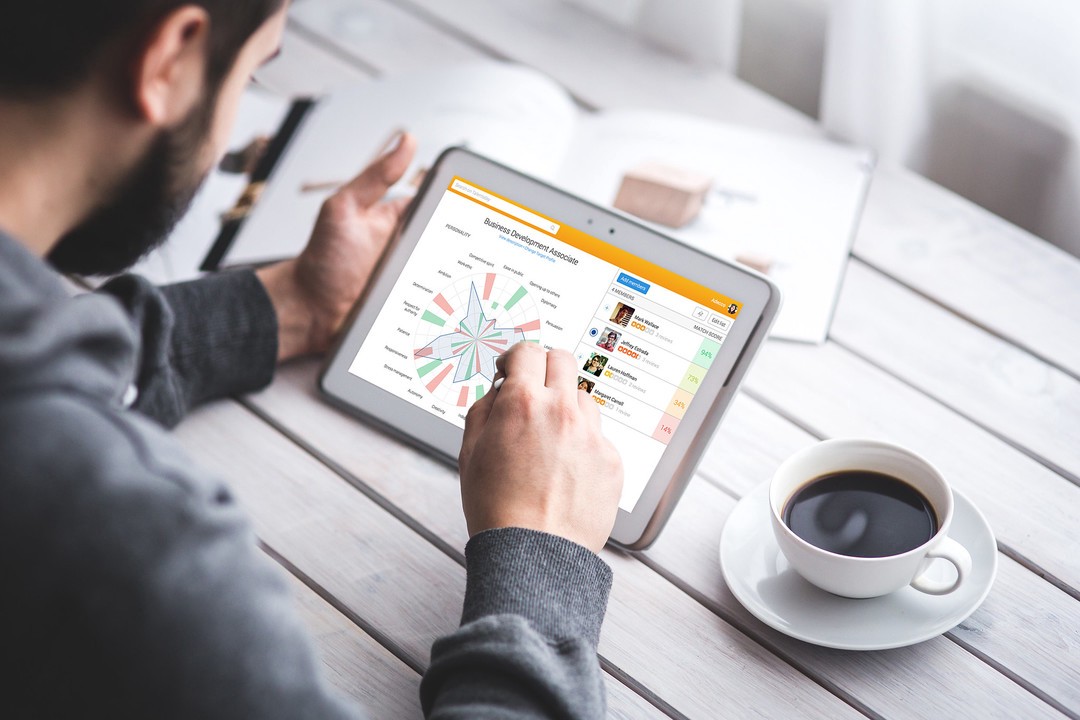
Today’s post deals with the relationship of strategy to human capital. Today, it is an inseparable pair whose interactions must be understood so that any adaptation, of individuals and organizations, to the new conditions of the working environment can be made in an optimal manner. Business models are changing, startups, however unstable, attract more young and dynamic executives, while large groups, large by their means, seem to fall off their pedestals*. If, at first glance, we realize, in dismay, that “the stability of an enterprise”, yet a dinosaur argument, is overcome by the dictatorship of the foosball, one wonders what will really motivate people to work in a company.
- Is it the technical skills?
- Is it the meaning of the missions?
- Is it the enrichment of individuals?
In other words, and to illustrate our point, we quote an excerpt from the book “Parallel Worlds” by Michio Kaku, American theoretical physicist and futurist.
“ All around you, there are hundreds of different radio waves being broadcast from distant stations. At any given instant, your office or car or living room is full of these radio waves. However, if you turn on a radio, you can listen to only one frequency at a time; these other frequencies have decohered and are no longer in phase with each other. Each station has a different energy, a different frequency. As a result, your radio can only be turned to one broadcast at a time.Likewise, in our universe we are “tuned” into the frequency that corresponds to physical reality. But there are an infinite number of parallel realities coexisting with us in the same room, although we cannot “tune into” them. Although these worlds are very much alike, each has a different energy. And because each world consists of trillions upon trillions of atoms, this means that the energy difference can be quite large. Since the frequency of these waves is proportional to their energy (by Planck’s law), this means that the waves of each world vibrate at different frequencies and cannot interact anymore. For all intents and purposes, the waves of these various worlds do not interact or influence each other.”
What about the neurosciences?
Neurosciences, and psychometry in particular, intervene to support this exercise of search and identification of “frequency” in the field of human capital management. A new way to rethink management. When psychometry sets foot in the company, in this place of authority, rules and processes, it is to bring intelligence and well-being to all those who are trying to escape by promoting the alignment of “frequency” of the individual with his work environment. And finally, it is also to bring more efficiency, competitiveness, to the organisation and ultimately results by almost drastically reversing the commitment of its employees. In conclusion, I invite you to discover your frequency. Take the test here for free or ask for a custom demo here!
MICHIO KAKU: Graduated from Harvard (B.sc.,1968) and Berkeley University (Ph.D.,1972). Engaged in work on the “theory of everything” seeking to unify the four fundamental forces of the universe. Among his books “ Physics of the Future: How Science will Shape Human Destiny and our Daily Lives by the Year 2100”.
* Only 9% of the employees in France say they feel engaged at work, Gallup 2013
Talentoday Manager keeps changing for the better
2017 was a busy year for our Innovation and Development team! Thanks to your feedback and their hard work, the Talentoday platform keeps evolving and delivering new and useful features.
Here’s an overview of some of the latest innovations now available on your Talentoday Manager app:
- Upgraded Reports: a new design and full customization capabilities are available for your Premium Development, Target Profile and Matching reports.
- Enhanced Labeling: The custom list filter further simplifies the mass labeling of your members.
- Improved Analytics: Individualized and branded Welcome Page links for your counselors, as well as powerful Microsoft Power BI dashboard and data export capabilities (into Excel/CSV) are now available.
- Extended Integration Capabilities: Complete or partial integration of Talentoday into your third-party HR tools is now possible, thanks to our Partners API and our embedded application.
1. New design and full customization of all reports
Our reports have a new look! You can now choose between the colorful Original Style and the smart new Classic Style, which provides the option of a sleek black & white modern look, and is perfect for more formal work environments.
With this choice of styles, Talentoday reports can be customized to better fit your or your client’s corporate culture. If you want to convey a sense of fun and vibrancy, choose the Original Style. If, on the other hand, you want to convey a more formal and refined feeling, the Classic Style is the best choice for you.
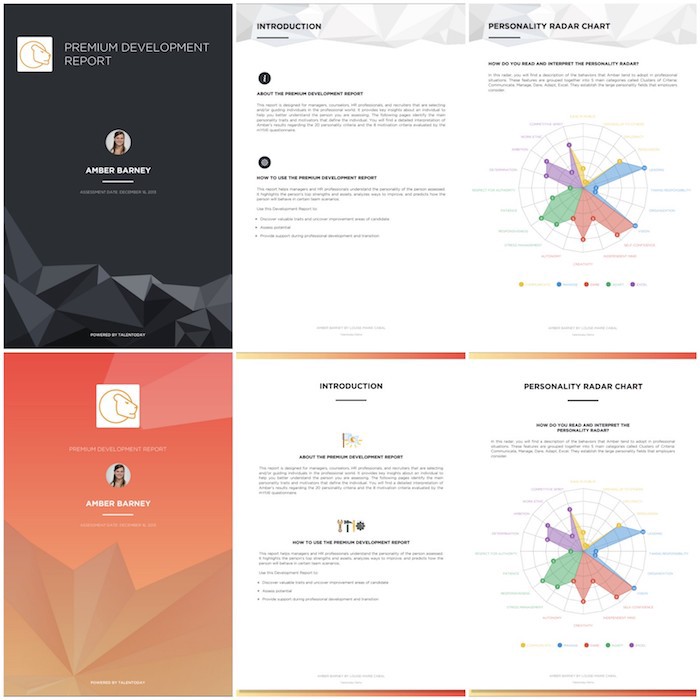
Either of these looks can be applied to all Talentoday reports, whether the Premium Development report, the Target Profile report or the Matching report, for a strong and consistent visual identity.
Last, but not least, you can now fully customize the Target Profile and Matching reports, just like you could with the Premium Development report. Just choose the sections you would like to include in your reports, according to your needs.
2. Labeling made easy
The labeling feature has also been revamped. Previously, you could choose between two ways to add labels to people: either pre-labeling them via the “New assessment” invitation box or manually choosing them one-by-one from the “People assessed” list.
This system works perfectly when you need to label a small number of people, but when it comes to mass labeling, it can become rather tedious. This is especially true when you use a Branded Welcome Page. Tagging a lot of people becomes cumbersome, since you won’t be using the “New assessment” invites. On the other hand, applying a new label to people you’ve already assessed can be time-consuming, since you’d have to look for them individually.
It is for this reason that we have simplified the process by creating the Custom List Filter.
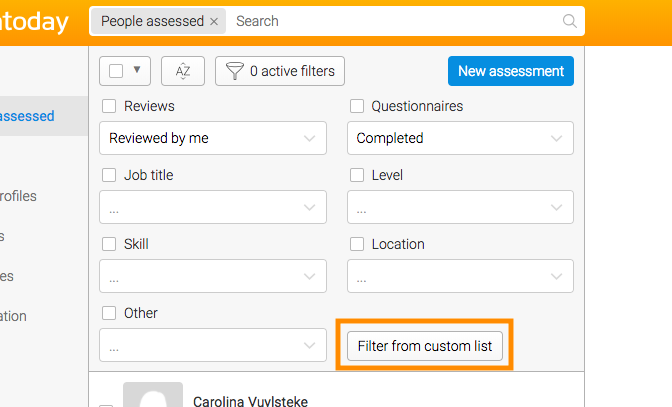
The Custom List Filter allows you to quickly and easily apply multiple labels to multiple people by letting our filter search your database for you! For instance, with the aid of a spreadsheet such as Excel, you can copy and paste the relevant email addresses and tag them with a simple click.
Don’t worry about accidentally missing someone. The custom filter pop-up window will tell you how many of your entries were found in your database.
3. Better analytics
Our Branded Welcome Page gave you the ability to alter the appearance of the Talentoday welcome portal by branding it to your business. However, tracking counselors’ activity was less manageable, since this page was linked to the account manager and not to each counselor. That’s why invitation links to the Branded Welcome Page are now specific to each counselor, allowing for an accurate analysis of your use of Talentoday.
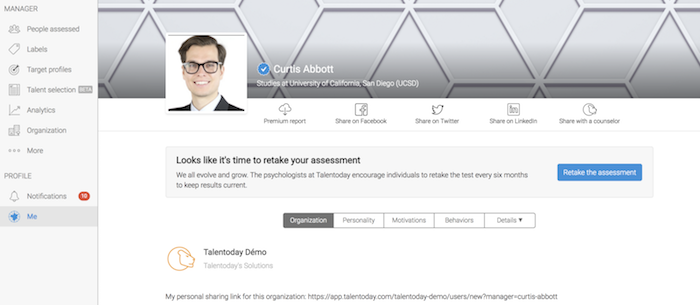
Some of our clients needed their data for statistical purposes or for reporting to other people in the organization. You can now export all your Analytics Data into a CSV file.
Do you need even more data, more detail and in real time? Ask for a custom dashboard! Using Microsoft’s Power BI technology, you can have access to a wide range of new information, such as the number of questionnaires completed over time or the most active counselors by branch. It allows you to perform a thorough analysis of all your Talentoday data.
4. Integrate Talentoday with your HR tools, thanks to our Partners API and embedded app.
Whether you want to incorporate a light version of Talentoday into your third-party HR applications, or completely integrate the Talentoday app (assessment, results and data included), everything is now possible with our Partner API and our new embedded app. Facilitate account creation by automatically populating the registration form with info from your HR tools, and assess your candidates without making them leave your website.
Click here for a more detailed explanation
As you can see, Talentoday continually strives to give you the best customer experience, and will keep changing for the better.
Up next: The innovative features we’re currently working on, which will be launched in the coming months!
Let us know what you think of these changes. We’d love your feedback! If you have any questions, please contact us via Twitter, Facebook or email.
Talentoday within your application!
In 2017, we saw an increase in the demand for integrating the Talentoday assessment process and results into third-party applications. These apps range from traditional digital platforms in the HR industry, such as HRIS or job boards, to more unconventional ones, such as freelance management software platforms. In this blog post, we will explain how integration is offered for partner apps, and how we can provide a fully unified and seamless experience for their users.
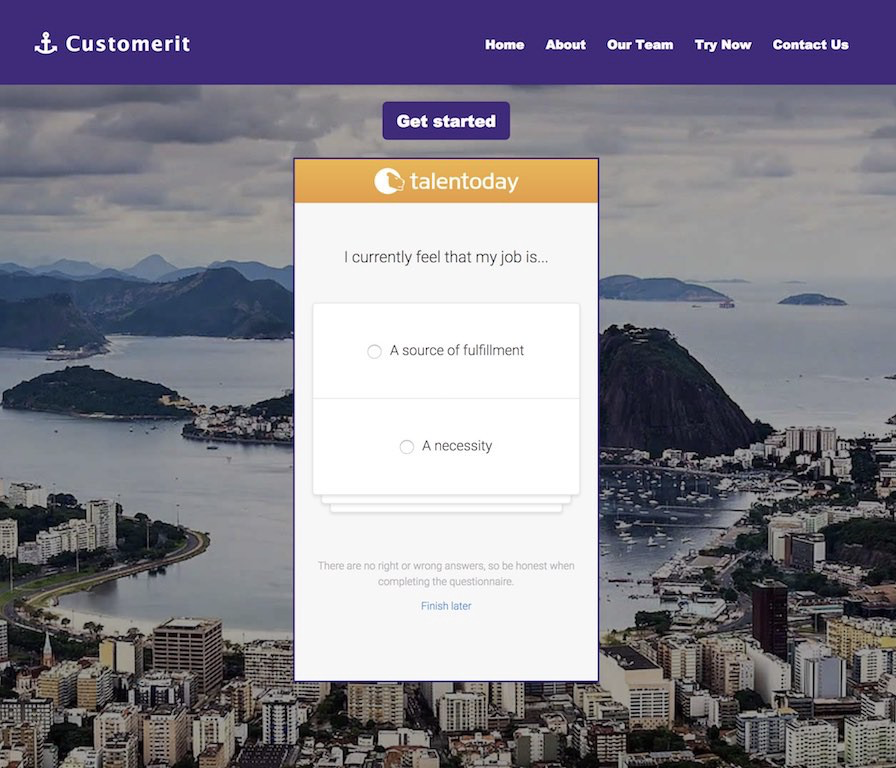
We are proud to announce that you can now easily integrate mYti© questionnaire in partners eco-system. The necessary toolkit has been released, and leverages two new key components:
- The Talentoday Partners API v1.1
- The embedded iFramed light application
The Talentoday Partner API v1.0 was released in January 2018. It has been designed, implemented and documented following the OpenAPI Specification. The purpose of the API is to take psychometric results of the organization’s members, and allow the programmatic distribution from raw data to consolidated reports. The users of this API are designated by the term “partners”, and are made up of existing customers of Talentoday Manager©, as well as partners from other applications where more value can be gained through the integration of a soft-skills component for their users. For example, this API allows you to list the organization’s members (a.k.a. people assessed). Thanks to webhook capabilities, the partner application is notified whenever a member of this organization completes the questionnaire, etc. As mentioned above, the Partner API allows the partner’s ecosystem to retrieve assessment scores and the resulting spider charts for personality traits and motivations, as well as structured PDF reports.
The iFrameable light application is a tactical way to integrate the Talentoday experience into your app. Specifically, the iFrame code is similar to the codes you can find on Youtube’s “embed” sharing code. The light mode application allows a person to sign-up for Talentoday services, and take the psychological assessment without leaving the partner app. Of course, members are still able to access their Talentoday account in the regular application on https://app.talentoday.com.
Leveraging the API will allow the partner to integrate personality results or any related material, such as spider charts, reports, etc. into their own web app, providing their users with a 100% integrated Talentoday experience.
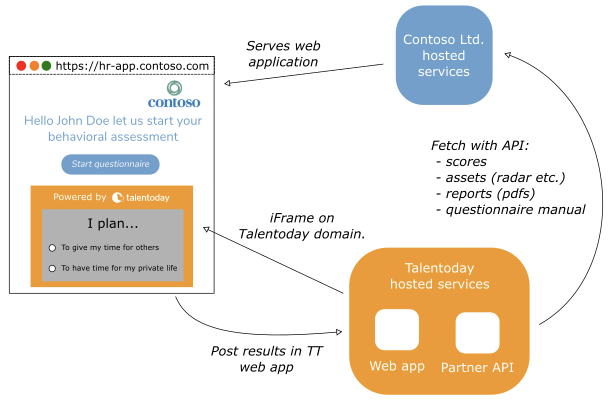
Interested by integrating Talentoday? Email us at contact@talentoday.com



